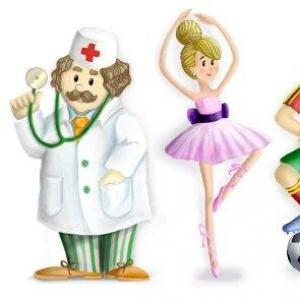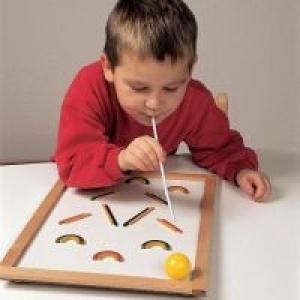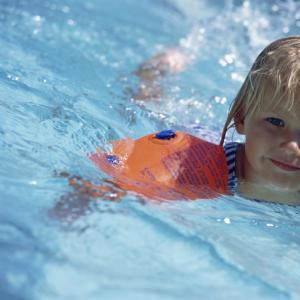“Features of teaching swimming to children of primary preschool age. The importance of swimming in preschool age Teaching swimming to children of older preschool age
The beneficial effects of swimming on children's bodies are generally recognized. In the medical and physiological aspect, this is the strengthening of various functional systems of the child’s body (cardiovascular, respiratory, musculoskeletal, etc.), in the psychological aspect, it is the formation of voluntary regulation of movements and actions, in the pedagogical aspect, this is not only teaching a preschooler complex actions , but also a way to develop self-regulation skills.
At the same time, the water area of a swimming pool is, first of all, a different habitat that places special demands on a person’s motor abilities. Therefore, trainers and teachers are unanimous that in order to get rid of childhood fears and the child’s general adaptation to water, an adaptation period is necessary.
Swimming as an activity is characterized by a significant degree of complexity, which inevitably enhances the element of learning to the detriment of play, which, from a psychological point of view, is the leading activity for preschool children.
Taking into account the psychological patterns of child development when organizing swimming lessons in preschool institutions requires that these classes be structurally and functionally built on the principles of “open learning” in school-age pedagogy. Open learning is not limited to strictly regulated frameworks and allows modifications, both at the will of the teacher and the will of the student. With this approach, the didactic space turns out to be a “meeting place” for the multidirectional motivated activities of a child (who wants to swim and frolic) and an adult (whose goal is to teach the child to swim). The child becomes the subject of his own swimming movements, and not the object of the instructor’s pedagogical requirements.
Thus, the formation of swimming skills in preschool children should be led not so much by a special method of teaching swimming, but by the need for the child to master a broader social experience - the water area of the pool.
There are a number of methods for teaching swimming to children of different ages. Good experience in group training of preschool children in “paddling pools” (G. Levin “Swim with the Kids”, 1974). He sets the following goals for teaching children to swim: to teach children to confidently and fearlessly float on the water; make maximum use of all factors that contribute to strengthening the health of children and their physical development; lay a solid foundation for further swimming lessons, which is not unimportant in the development of children. But it should be noted that his method has a drawback - learning to swim begins directly in the water. Before immersion in water, you need to prepare the child for behavior in water with the help of special breathing exercises and moving through the water (getting used to water).
The basic swimming training program adopted by teachers of most kindergartens can be considered the method of T.I. Osokina (Osokina T.I., Timofeeva E.A., Bogina T.L. Teaching swimming in kindergarten. M.: “Prosveshchenie”, 1991).
The methodology for teaching swimming to preschool children should be based on the basic didactic requirements of pedagogy and have an educational and developmental character. General didactic principles - consciousness, systematicity, clarity, accessibility, strength and particular methodological provisions of the theory of physical education - the principle of increasing load, repetition are carried out when conducting classes in accordance with the age characteristics of children.
An individual approach is required when working with preschoolers. The fragility and immaturity of the child’s body requires careful consideration of the abilities, inclinations, and most importantly, the capabilities of each child. Only with strict consideration of gender, age, degree of physical development and health, susceptibility to colds, habits of water and changes in temperature conditions, individual reactions to physical activity can one find the most correct methods for teaching swimming to children.
The leading place should be occupied by the gaming method. It ensures the necessary interest of children in learning to swim, allows you to increase the number of repetitions of the same exercises, and use a variety of starting positions. The use of games helps ensure that the lessons are emotional. The playful nature of learning also reflects the need for an attentive, demanding, but at the same time, relaxed and affectionate approach to children, and determines the active participation of the teacher in the learning process.
Games, as a rule, should contain swimming elements previously learned by children and various preparatory exercises for swimming. Simple and accessible didactic aids, varied in form and purpose, should be used in training.
Mastering various movements occurs by repeating them many times. The number of repetitions should increase gradually. Considering that repetition of movements is a monotonous activity and tires children, they should be asked to perform a variety of exercises in one lesson.
Based on imitation, preschoolers better master integral motor acts. Therefore, it is necessary to create in them a holistic understanding of the method of swimming being studied. To do this, both in the first and in subsequent lessons, it is necessary to repeatedly demonstrate this method performed by a child or adult who can swim.
Due to the peculiarities of the development of children's thinking at this age (concreteness, objectivity, a strong ability to imitate, etc.), demonstration is very important when learning to swim. All exercises and movements that children learn must be demonstrated by the teacher. The demonstration must be carried out under the same conditions in which the exercise will be carried out (on land, in water).
It is especially important when learning to swim to demonstrate exercises performed in the water. In this case, children not only visually perceive the structure of the movement, but also become convinced that performing this movement in water is quite possible. This, in turn, generates confidence and courage when performing exercises, and contributes to the rapid formation of new skills.
Children do not always immediately grasp the correct execution of a new movement. Therefore, it must be demonstrated many times, both in one and over several lessons.
It is best to demonstrate the exercises immediately before performing them, performing all movements correctly, clearly, easily and beautifully, without tension.
We must always give children the opportunity to show their achievements in completing certain tasks to the teacher or other children. This activates their participation in the learning process and can serve as a disciplinary factor.
The display must be accompanied by explanations accessible to children. A story, conversation, explanation, and timely remark stimulate purposeful, conscious mastery of movements.
Images occupy a large place in the thinking of a preschool child. In teaching swimming, figurative comparisons in the names and explanations of exercises should be widely used. Names of exercises such as “Eyes in the Water”, “Nose Drowned”, “Crayfish”, “Shark”, etc., help create real ideas about the exercise to be performed and make it easier to master it. Naturally, the image must be understandable to children, otherwise imitation is impossible. But it must be borne in mind that focusing only on simulation exercises or being overly enthusiastic about the entertaining nature of the image negatively affects the overall organization of the students and the accuracy of the exercises. Therefore, there is no need to abuse them.
The teacher's explanation and story during swimming lessons should be presented in a clear, expressive form. The tone of the conversation should always be even, calm, but quite impressive. The authoritatively presented demand is unconditionally fulfilled by preschoolers.
When working with children aged 4-6 years, you should not use a large number of commands and calculations when learning exercises. The main thing in group classes is the authority of the teacher: his look, facial expression, tone, gesture call the children to order. They need to feel in control of their behavior.
This helps children concentrate and teaches them to complete a task at the first word from the teacher. During classes, children need to be reminded that they are being watched, make comments, and often repeat: “I’m watching,” “show,” “do,” “I’ll watch,” etc.
The teacher’s attitude towards children in the group should be sensitive, affectionate, and equally equal to everyone. If possible, the requirements put forward should be the same, but, of course, we must not forget about the individual characteristics of children.
The teacher’s demands should not be imposed on children; they must be presented tactfully and correctly. It is important to create in children a sense of independence in their actions.
Swimming lessons are very emotional for children. They splash, splash, and swim with pleasure. But sometimes their behavior in the water becomes too noisy, overly excited, children lose the ability to respond to the demands of the teacher. In such cases, punishment can also be applied.
One of the punishment measures is a reprimand with a precise indication of the reasons for the teacher’s dissatisfaction. Children who grossly violate class discipline can be removed from the water and not allowed to attend classes. When punishing a preschool child, one must maintain respect for his personality. The offender must be taken out of the water, told to get dressed and, as an edification to others, be seated on a bench during classes in front of the whole group. At the next lesson, you need to pretend that nothing happened and continue to talk to the child in a friendly manner.
This attitude, as a rule, somewhat confuses the punished; he tries to fulfill all the requirements as best and as carefully as possible. Children love to bathe and swim, so in most cases, just a reminder of the possibility of losing this pleasure gives the necessary results.
Mastering the skill of swimming is quite difficult for preschoolers. In this regard, in teaching them to swim, it is necessary to use a significant number of different preparatory exercises and games.
Children are first introduced to each exercise on the shore, and then learn it in the water. Familiarization with new educational material on the shore is important, since the time children spend in the water is limited (10-15 minutes), and the aquatic environment excites them extremely, as a result of which their attention is scattered and they do not perceive unfamiliar material well. In addition, being in water without moving during explanations and showing new material, children quickly cool down due to increased heat transfer.
But too much exercise on land also leads to a decrease in attention. Therefore, it is advisable to offer children 2-3 exercises on land, and then work with them in the water.
The dosage of load when performing exercises for girls and boys is the same, but varies depending on the age of the children: children 3-4 years old are given a slightly lower load than children 5 and even more so 6 years old.
The instructions given below for the dosage of the load in each specific case may be changed by the teacher. For example, at low water and air temperatures, the number of repetitions of exercises can be reduced, and the intensity of their implementation increased (fewer exercises done at a higher pace).
Exercises in water should always begin with vigorous movements. They should be completed by calmly diving into the water with your head and exhaling into the water. Depending on the age of the children, this exercise must be repeated at the end of classes from 4-5 to 10-12 times or more. Free swimming increases the emotional intensity of activities and gives children the opportunity to independently try their hand at performing certain technical techniques and attempting to swim. To develop activity and initiative in children, it is necessary to introduce free swimming into their classes.
Children's mistakes need to be corrected during classes in a certain sequence. Naturally, at first the child makes significant mistakes in crawl swimming. Most often in preschoolers they depend on the degree of general physical and coordination readiness. We must strive to ensure that children master the general pattern of movements of the swimming method. Due to mobility and imbalance of nervous processes, preschool children have difficulty making precise, clear movements. There is no need to immediately demand from them precision in swimming technique. It can only be developed over a long period of time. But some gross violations in front and back crawl swimming in preschoolers must be promptly and consistently corrected.
A high position of the head causes incorrect posture of the torso and makes breathing difficult. Therefore, first of all, you need to correct the position of the body and head, then achieve proper breathing. With a low position of the pelvis, the legs sink deep into the water, balance in the water is disturbed, the legs work sluggishly, and sometimes even stretch without movement. Or, conversely, children make sharp, irregular, poorly coordinated leg movements, their legs are strongly bent. You need to pay a lot of attention to correcting leg movements: until the guys learn how to work their legs correctly, they should not rush to correct other mistakes. After errors in the movements of the legs have been eliminated, you can begin to correct the movements of the arms, and then in the coordination of all movements.
First you need to notice the main mistake. Correcting it often leads to eliminating minor minor errors. You cannot correct several mistakes at the same time - this distracts the children's attention. Errors should be corrected by giving instructions for the correct execution of the movement and clarifying the execution of the movement as the action progresses. At the same time, the teacher must actively use repeated demonstrations, focus on the correct execution of movements by individual children, and organize their execution in pairs for mutual self-control.
/* Style Definitions */
table.MsoNormalTable
(mso-style-name:"Regular table";
mso-tstyle-rowband-size:0;
mso-tstyle-colband-size:0;
mso-style-noshow:yes;
mso-style-priority:99;
mso-style-parent:"";
mso-padding-alt:0cm 5.4pt 0cm 5.4pt;
mso-para-margin-top:0cm;
mso-para-margin-right:0cm;
mso-para-margin-bottom:10.0pt;
mso-para-margin-left:0cm;
line-height:115%;
mso-pagination:widow-orphan;
font-size:11.0pt;
font-family:"Calibri","sans-serif";
mso-ascii-font-family:Calibri;
mso-ascii-theme-font:minor-latin;
mso-hansi-font-family:Calibri;
mso-hansi-theme-font:minor-latin;
mso-fareast-language:EN-US;)
“Features of teaching swimming to children of primary preschool age”
Balbukh Alevtina Valentinovna,
physical education instructor
Municipal educational institution d/s No. 350 of Volgograd
One of the most important tasks of preschool education, in accordance with the Federal State Educational Standard, is to create the most favorable conditions for protecting and promoting the health and harmonious physical development of the child. These problems are successfully solved in swimming lessons in kindergartens. Purpose of swimming lessons- creating the necessary conditions for preserving and strengthening the physical and mental health of children through the formation and development of motor skills and abilities in the water.
The effect of swimming on a child’s body cannot be underestimated. It helps you become healthy, strong, agile, resilient, and courageous. Swimming from an early age promotes the development of the respiratory system, has a positive effect on the cardiovascular system, and promotes the formation of correct posture. Teaching a child to swim is not only a useful life skill, but also an opportunity to strengthen the immune system, because swimming is one of the most effective methods of hardening.
In our preschool institution, children begin to visit the pool from the age of 3, because it is important to begin the process of learning to swim as early as possible. Experts understand this, and parents want this too. From the first day of visiting kindergarten, parents are interested in the question: when will their baby swim in the pool. In their opinion, all children love water very much and enjoy splashing in the bathtub. Sometimes parents do not understand why it is necessary to first master breathing and motor techniques on land, and only from the middle of the school year classes take place in the water. Therefore, information from a swimming instructor is important for parents, what tasks are solved in the first year of learning to swim, what methods and techniques are important to use, what characteristics of young children need to be taken into account.
The first year of swimming training is, in addition to general strengthening and health-improving goals, solving a number of specific problems:
- getting used to water;
- water development;
- mastery of breathing and elementary swimming movements.
It should be understood that most children have a feeling of hydrophobia, because for most children a pool is not a bathtub for swimming, it is a huge expanse of water. This anxiety must be overcome gradually, without violence or coercion. Classes in the pool include a lot of preparatory work, which helps children cope with the fear of water, with self-doubt, get acquainted with the properties of water, learn to float on the water and, as a result, master swimming skills in an easier way. Children need time to get used to water and learn not to be afraid of it and to breathe correctly in an aquatic environment.
Therefore, at the first stage, children master breathing exercises that take place “on land.” The baby learns to inhale through the mouth and exhale through the nose and mouth. The main thing is to set the rhythm. "Once!" - inhale, “Two, three!” - exhale. Various game exercises help us with this - for example, blowing paper snowflakes or fluff from the palm of our hand. With each lesson, children are offered large objects that need to be moved from place with the help of breathing: balloons, tennis balls and others.
Game "Legs apart". Ask the child to stretch his arms up, place his hands one on top of the other, and press his chin to his chest. Complete 10 phases. Make sure that the baby “tightens” his stomach while doing this.
Funnel game. For this game we need colorful bowls of water. Ask your baby to blow on the surface of the water until a funnel forms. Play with your children and turn the exercise into a competition: whose funnel will be deeper?
Game "Bubbles". After inhaling, he lowers his head into a basin of water and exhales deeply. Again, have a competition: who can make the most bubbles? Make sure that the child does not wipe his eyes with his hands, but shakes off the water with head movements. It is very important! This exercise is great for teaching how to hold your breath. Do the same exercise, only hold your breath with your head lowered into the water. Also in my work, for the initial adaptation of children to water and hardening, I use various washings and dousing children with a watering can. The main goal of these training exercises is to prevent the child from swallowing water and getting scared in the pool. The rule is based on this: first, classes take place on land - the so-called “dry swimming”, and only then classes take place in the water.
In addition to breathing exercises, children at this stage master motor and swimming skills, master game exercises to teach footwork, coordination of breathing with footwork, learning to work with hands, and general coordination of footwork, hands and breathing. Taking into account the visual-figurative nature of thinking of children of this age, literary material and musical accompaniment are used in classes so that children can recreate a particular image and are able to imitate movements.
All tasks and exercises performed by children, both on land and in water, should be turned into a game. It is the game that is the leading activity of the child.
From the 2nd half of the year, the following tasks are solved with children 3-4 years old:
- teaching children how to enter water, familiarizing themselves with the properties of water, overcoming fear of it.
- learning to move along the bottom of the pool in different ways at different depths.
- learning to dive into water with open eyes; learning to breathe in water (exhale into the water).
The first trip to the pool is an event in the life of a preschooler. A large, bright room, a sparkling blue mirror of water, splashes and splashes literally stun the kids. It is up to the swimming instructor to ensure that these impressions are positive.
During the first lessons, children learn how to enter the water. The main difficulty in entering the pool is most often due to the fact that children go down the stairs into it, on which they can trip, slip, or fall into the water. After swallowing water, the child may get scared and not want to come to the pool anymore. It is important to prevent it from unexpectedly falling into the water.Children cannot be forced. Anyone who enters the water reluctantly, hesitantly, can be picked up and moved with the palm of his hand over the surface of the water, saying: “What smooth, warm, gentle, kind water!” Then the child should be placed in the water facing you, taken by both hands and, quietly retreating, calling for you. When the children get used to the water and begin to move around on their own, they walk around the pool, holding the handrail or my hand. It is not recommended to use all kinds of intimidating language. You can always choose expressions in which the threat of danger is completely absent: “Be bolder,” “Do as everyone else does,” “Well done.” Young children need 4 lessons to learn how to enter the water. There are always anxious children in the group, with whom you need to work separately, observing great delicacy, convincing of the feasibility of the task using the example of other children.
After children have learned to enter the water on their own, they need to be taught basic movements. Children feel how much more difficult it is to move in water than on land. Various exercises (walking, running, jumping) are not difficult for children; they perform them with pleasure if the depth is small and corresponds to the actual level of readiness of the children. First, these exercises are carried out at a depth below the knees and up to the knees. Gradually the depth increases to the level of the hips and waist. Children learn to walk alone (“We are walking”), in a group (“Friendly guys”), holding on to a stick (“Cart”), walk along the side of the pool in large and small steps, holding on to the handrail (“Feet walk along the path”), in a given direction (“On a straight path”), to a designated place (“Reach the fish”), in a circle, holding hands (“The carousel is spinning”), helping yourself with rowing movements with your hands (“Boats”). Children especially enjoy running into the water and running out of it, splashing their feet, raising splashes (“Football players, “Bring a toy”), raising their knees high (“Like horses”), helping themselves with their hands (“The oars are rowing”), and running away from an adult and catch up with him (“Catch-up”), fall into the water from a running start (into the hands of the instructor).
The best exercise is jumping. They help to warm up well, cheer up, and unobtrusively prepare the baby for immersion in the water. Children learn to jump on two legs with the support of an adult, holding on to a handrail, as well as without support (“Grey Bunny”, “Ball”), “leaning”, pushing off with their palms on the water (at waist-deep depth) and squatting (“Let's hide in the water "). They learn to move forward on two legs, jump long from a standstill, jump and fall forward into the water at a depth of hips, waist-deep (“Airplane”).
Training in hand movements is of no small importance. Children clap the water with their palms, depicting “rain”, knock on it with their fists, like a “hammer”, stroke the water with their palms, like an “iron”, move their hands up and down, left and right, depicting “rinsing clothes” or “waves”, crossing the fingers of the hands, they depict “chopping wood.” A special place is occupied by moving along the bottom on your hands, with your legs stretched out. These exercises lead to the ability to assume a horizontal body position in the water. They are performed at shallow depths and are often difficult for children to master. Therefore, the younger group only uses crawling on their stomach (“I’ll crawl to the boat”, “Crocodiles”, “Crayfish”).
The next step in mastering water, which young children take, is immersion. Unfortunately, not all children find immersion in water easy. Psychologically, it is very important that the child plunges headlong into the water on his own for the first time. Under no circumstances should you force him to do this if he doesn’t want to, throw him, push him into the water, etc. Otherwise, the child will develop a fear of water, and the desire to swim may disappear for a long time. If on land, immersion in water (in a bowl of water) with holding your breath has been practiced, then children will not experience problems with this exercise in the pool.
While learning to dive up to their necks in waist-deep water, children wash their arms, shoulders, chest, neck, face, pour water on their backs (“Chistyuli”), and play games with them: “Little frogs wash themselves,” “Let’s make it rain” (spray yourself in face). When teaching the game exercise “Waterfall”, when kids pour water from a bottle on their heads, it is important to teach them to breathe with their mouths slightly open. In this case, the unpleasant sensations from water getting into the nose are eliminated, and children get used to the feeling of water on their face. And only after that the children are immersed to chin level (“Islands”).
The following exercises involve directly immersing your head in water (“nose drowned”, “eyes in the water”, “look into the well”, “get a toy” and immersion in water with your head, holding your breath as you inhale). Then children are introduced to simple exercises that lead to mastery of exhalation: blow on a floating toy; on water as on hot tea; dip your lips in water and lather it; immerse your head in the water and exhale. Children learn to breathe into water for a long time. At the same time, children learn to open their eyes in water. After high physical activity, children are given relaxation breaks to relieve muscle tension. Children, with the support of an instructor or wearing armbands, relax on the water, lying on their backs, or perform exercises to restore breathing (“funny bubbles”, “say goodbye to water”).
All children who regularly attended classes in the pool do not experience fear in the water, move fearlessly around all areas of the pool, and perform play exercises in the water with joy and desire, which allows them to easily master the swimming training program.I would like to emphasize once again: each lesson should be aimed at developing in the baby only positive emotions and feelings - joy, pleasure, as well as interest and pleasure from being in the water. This will increase the effectiveness of swimming lessons, which will help strengthen and improve the health of children’s bodies.
References:
- Bulgakova, I.Zh. Meet - swimming [Text] / I.Zh.Bulgakova. - M.: ast astrel, 2002.
- Egorov, B.B., Vedernikova, O.B., Yakovleva, A.V. and others. Health complex in kindergarten: swimming pool - herbal bar - sauna [Text]: methodological manual / ed. B.B. Egorova. - M.: Gnom i D, 2004.
- Protchenko, T.A., Semenov, Yu.A. Teaching swimming to preschoolers and junior schoolchildren [Text]: methodological manual / T.A. Protchenko, Yu.A. Semenov. – M.: Iris didactics, 2003.
- Sokolova, N.G. Swimming and baby’s health [Text] / N.G. Sokolova, - Rn-D.: Phoenix, 2007.
THE IMPORTANCE OF SWIMMING IN THE LIFE OF PRESCHOOL CHILDREN
Preschool workers are given the most important tasks to protect life and promote health, improve the physiological functions of the child’s body, and increase its protective properties. In this regard, in the general system of physical education in kindergarten, a large place is given to swimming. Swimming is an excellent means for developing and improving the physical qualities of a preschool child and has a significant impact on his health. From a very early age, this is one of the most powerful forms of influence on a developing organism, a combination of water, air, temperature and motor activity of the child.
Swimming:
- hardens the body, improves the mechanism of thermoregulation, increases immunological properties, improves adaptation to various environmental conditions;
- instills the ability and skills of self-service;
- improves the circulatory and respiratory organs, improves cardiac activity, chest mobility, breathing rhythm, increases the vital capacity of the lungs;
- strengthens the musculoskeletal system, correctly forms the spine, develops good posture, and prevents the development of flat feet;
- increases muscle performance and strength;
- harmoniously develops strength, speed, agility, flexibility, coordination of movements, endurance; improves movements;
- increases the overall tone of the body, strengthens the nervous system, sleep becomes stronger, and appetite improves.
Swimming lessons are of great educational importance. During training, conditions are created for the formation of personality, which contributes to the development of purposefulness, perseverance, self-control, determination, courage, discipline, independence, creativity, as well as the ability to act in a team. The ability to swim is a skill needed by a person in a wide variety of situations.
Hence, the great importance of mass swimming training for children
Preschool age. There is no need to point out the significant number of water accidents that occur annually due to inability to swim. A large percentage of them fall on children. If all children from a very early age are taught to float freely, to swim at least a short distance, then many children’s lives will be protected from possible misfortune.
The main goal of teaching swimming to preschoolers is to promote their health, hardening, and provide comprehensive physical training. At the same time, learning to swim at an early age is of great importance for the wider involvement of children in such mass sports as rowing, sailing, tourism and others. It is as necessary a skill as the ability to run, jump, ski, ride a bicycle, etc. Many famous swimmers learned to swim at the age of 4-5 years, and were already training regularly at 6-8 years old. Therefore, it is very important to discover children’s abilities for competitive swimming as early as possible, and to develop the desire for intense competition and victories in this field.
Many professions and professional activities often require good swimming skills, and active recreation usually includes swimming in ponds and pools.
The enormous impact of swimming on a child’s body is universally recognized, so teaching a child to float on the water means instilling in him a vital skill.
Starting from a certain age of the child, many parents think about in what narrower direction to direct his colossal energy. Of course, the choice of a future activity is directly influenced by the child’s inclinations, personal qualities and abilities, but there are objective criteria for choosing a section:
- stimulation of physical and mental development;
- health benefits;
- pleasure from classes.
One of the first on the list of such activities is swimming. Firstly, it strengthens the muscles of the spine and the entire body as a whole, laying an excellent foundation for health. Secondly, constant swimming lessons not only have a beneficial effect on physical development, but also develop in the child such character qualities as determination, perseverance and patience. Thirdly, with the right approach, the learning process can bring a lot of vivid emotions and impressions. And even if your baby does not become a star in one of the water sports, the ability to swim will be useful to him in everyday life.
When, how and where to start swimming lessons?
Giving preference to swimming, parents are faced with a number of questions - for example, at what age is it better to start teaching children to swim, and where to actually start trying to teach a child to swim. Parents of those children who have not yet turned 7 years old are interested in the question of the peculiarities in teaching swimming to preschool children.
Starting too early will not bring any special dividends. For children after one year and up to 2-3 years old, regular bathing with their parents and toys intended for water will be quite enough. The benefits of swimming with running along the bottom, jumping out of the water, splashing and floundering will be equivalent to the benefits of swimming according to all the rules, with appropriate movements of the arms and legs and proper breathing, but in the first case the baby will definitely get more pleasure from the process.

 The swimming section is one of the best options for additional activities for a child. Swimming brings great pleasure and helps strengthen the body. But you need to start classes no earlier than 5 years
The swimming section is one of the best options for additional activities for a child. Swimming brings great pleasure and helps strengthen the body. But you need to start classes no earlier than 5 years In any children's swimming section, coaches do not recommend trying to teach a child to swim, much less introduce him to styles in preschool age. Starting from 4-5 years old, you can teach your baby to lie on the water in a supine position. It would be useful to tell him about the physical qualities of water - for example, about its resistance to the movement of arms and legs.
It is useful to explain to your child the main nuances associated with the swimming process itself:
- sinking under water, a person exhales, and on the surface of the water inhales;
- being in a horizontal position, it is easier to stay on the surface of the water than in a vertical position.
The ideal age for learning to swim is 6, 7 or 8 years old. Such children are already able to understand what is required of them, and this plays an important role in achieving a positive result.
Who should take their child swimming and how?
Parents themselves can teach their baby basic swimming skills and techniques. To do this, it is not necessary to know all the styles and have the technique of a professional swimmer - the main thing is that the child is not afraid and feels confident in the water. If you want your child not only to be able to swim, but also to master various styles and the correct technique, it is better to resort to the services of a children's coach who teaches swimming.
Whatever school or swimming section is chosen, most adhere to the generally accepted lesson plan:
- dry land exercises;
- exercises in water;
- water games;
- free swimming.

 If a child shows interest in classes, and parents would like to ensure his sports future or instill skills in various swimming styles, it is better to study with a professional coach
If a child shows interest in classes, and parents would like to ensure his sports future or instill skills in various swimming styles, it is better to study with a professional coach Swimming pool and additional aids
A significant role in the process of learning to swim is played by the place where the lessons are held, and more specifically, in which pool. At the initial stage of learning, the pool should not be too deep, since a baby starting to swim needs to reach the bottom well with his feet, and the water should not exceed the level of the lower part of his chest. It is advisable that the length of the pool is not less than 6 meters. At this distance, it will be easy for the child to perform the main exercise - sliding.
Now there are a large number of all kinds of auxiliary things for learning to swim: fins with vests, inflatable rings and arm sleeves, much more. All these devices only harm and slow down learning. In the same sleeves, the child develops the habit of holding his head vertically above the water, while leaning on his armpits. As a result, the baby will not be able to feel the buoyancy of his own body, which will subsequently lead to the inability to stay on the water on his own. The most suitable assistant in the learning process is a swimming board. With its help, the child will be able to remain strictly parallel to the surface of the water, immerse his face under the water and slide using his legs.
Effective exercises to do at the beginning of training
In order to teach a child to lie on the water in a horizontal position and fearlessly lower his face into the water, use the following simple and easy-to-perform exercises:
- "Star". It is necessary to lie strictly horizontally on the water and spread your legs and arms to the sides in the shape of a star.
- "Float". Bend your knees, pull them to your chest and clasp them with your arms, pressing your head to your knees. Fix the position on the surface of the water.
- "Arrow". Push off with your feet from the side of the pool and, stretching out your legs and arms, slide on the surface of the water.

 Initially, the child should be taught to simply float on the water, and only after that can he proceed to diving under water
Initially, the child should be taught to simply float on the water, and only after that can he proceed to diving under water When moving on to diving your head under water, you should always remember that such exercises are contraindicated for children who have problem ears or nose - for example, a damaged eardrum, otitis media or sinusitis. In these cases, you should limit yourself to exercises without putting your head in the water.
Breathing technique
One of the important aspects of swimming is proper breathing. His technique is inhale quickly through the mouth and exhale long through the nose. A child’s mastery of such technology is not only necessary, but also useful. The baby will become more resilient and will be able not only to swim for a long time without getting tired, but also to run and jump for a long time on land.
How can you help your child master proper breathing techniques? Breathing training should begin on land, as it is often difficult for a child to monitor breathing and hand movements at the same time. You can also use a regular basin of water for exercises: inhale and exhale into the water. The main thing is to make sure that the child does not hold his breath when performing the exercise. Gradually you can move from the basin to the pool. Over time, such exhalations into the water will become a habit for the baby.
Sequence of training
Any training has its own sequence of presentation of the material. Swimming is no exception.

 First, the child learns to swim with auxiliary elements, using only footwork. This is needed to automate the skill
First, the child learns to swim with auxiliary elements, using only footwork. This is needed to automate the skill The order in which you need to master the movements is as follows:
- sliding on water;
- footwork;
- working with hands, ideally, each in turn;
- breath.
Each movement should be brought to automaticity and only then move on to the next one. When performing certain movements, make sure that they are continuous, smooth, and that individual muscles remain relaxed. But exercises on land, such as circular rotations of the arms with simultaneous turns of the head to the right and left, standing on one leg with arm movements to the sides and up, help coordinate movements.
Following the above rules, all parents must follow the most important rule - continuous supervision of a child who is in the water. As a result of common efforts and teamwork, your family collection of home videos will be replenished with unforgettable footage of your child masterfully swimming in the sea on vacation or in the nearest river in the village at his grandmother's. You can watch the video on how to prepare your child for attending the swimming section.







